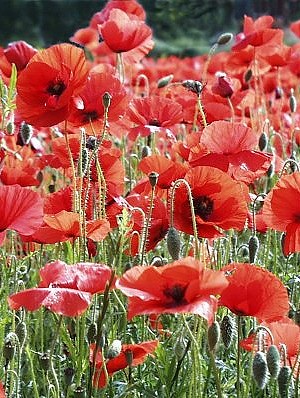
|
|
Field
of poppies (Papaver Rhoeas)
|
Field Poppy
- Papaver Rhoeas
This is probably one of the most popular wild flowers in
Europe, both for its beauty, and its WorldWar II memorial. The plant is an annual herb which readily germinates from
seeds. The branching stems have fine white or purple-red hair all along, especially at the flowering
part. The flower stems are quite slender, and holds the solitary and terminal
flowers. The bud is hanged upside down and then assumes a normal position just before
blossoming. The stems have a white milky sap.
Most of the leaves are more or less found at the middle or lower part of the
stem, leaving the flowers more conspicuous. They are stalked, oppositely-LYY arranged on the
stems, and are so deeply pinnately-LYY divided, that each pinna (leaf
lobe) is independent. They also have a coarsely serrated outline. The leaf
pinnae-AEE and serrated outline varies from plant to plant.
The flower consists of 2 hairy sepals and 4 bright red to red-crimson
petals, often having a dark blob at the base. The blob also varies from plant to plant and some may even lack
it. The petals are fragile (detaches easily from the flower) and their size vary
considerably, but can-ANN form flowers of about 50mm in diameter. At the center there is a globular or
pot-shaped gynoecium that is pale green in colour and has radiating darker stripes at the
top. The stigma are found upon these stripes. The base of the gynoecium is encircling by a cluster of many black stamens with anthers that may be covered with pale yellow or grey
pollen.
The fruit is a seed capsule which is pale green and turns yellowish or light brown when the seeds
matures. The glabrous seed-capsule is pot-shaped with a flattened top (lid) that has a slightly serrated
circumference. The dehiscent poricidal capsule is operculate (possess a lid
structure). It does not split open, but instead, the tiny (1mm), brown, kidney shaped seeds escape from pores at the lid part of the capsule when wind causes it to
sway.
Origin of the Poppy is probably Asia and Far East. According to reference this plant is native to Northern
Africa, Western Asia and Europe It is also naturalized in North America.
Papaver Rhoeas is very slightly narcotic. The chief constituent of the fresh petals is the red colouring
matter, which consists of Rhoeadic and Papaveric acids. This colour is much darkened by
alkalis. All parts of the plant contain the crystalline non-poisonous alkaloid
Rhoeadine. The amount of active ingredients is very small and rather uncertain in
quantity. There is great controversy as to the presence of Morphine. Also it has not been determined whether Meconic
Acid, which is present in opium, is a constituent.
The flowers of corn poppy have a long history of medicinal usage, especially for ailments in the elderly and
children. Chiefly employed as a mild pain reliever and as a treatment for irritable
coughs, it also helps to reduce nervous over-activity. Unlike the related opium poppy (P.
somniferum) it is non-addictive. However, the plant does contain
alkaloids, which are still under investigation, and so should only be used under the supervision of a qualified
herbalist.
The flowers and petals are anodyne, emollient, emmenagogue, expectorant,
hypnotic, slightly narcotic and sedative. An infusion is taken internally in the treatment of bronchial complaints and
coughs, insomnia, poor digestion, nervous digestive disorders and minor painful
conditions. The flowers are also used in the treatment of jaundice. The petals are harvested as the flowers open and are dried for later
use. They should be collected on a dry day and can be dried or made into a
syrup.
The latex in the seed-pods is narcotic and slightly sedative. It can be used in very small
quantities, and under expert supervision, as a sleep-inducing drug. The leaves and seeds are
tonic. They are useful in the treatment of low fevers.
The plant has anticancer properties.
Many parts of papaver are edible. Seeds - raw or cooked. Much used as a flavouring in
cakes, bread, fruit salads etc. it imparts a very nice nutty flavour. The seeds are rather
small, but they are contained in fairly large seed pods and so are easy to
harvest. The seeds are perfectly safe to eat, containing none of the alkaloids associated with other parts of the
plant. An edible oil is obtained from the seeds. This is said to be an excellent substitute for olive
oil, it can be used in salad dressings or for cooking.
Leaves - raw or cooked. Used like spinach or as a flavouring in soups and
salads. The leaves should not be used after the flower buds have formed. Some caution is
advised, see the notes above on toxicity. Flower - A syrup can be prepared from the scarlet flower
petals, it is used in soups, gruels etc. In the past it was also used as a substitute for
tea. A red dye from the petals is used as a food flavouring, especially in
wine.
Poppy was
the sacred plant of Demeter, the godess of fertility. Ancient Greeks thought that poppies were a sign of
fertility. Poppy seeds were thought to bring health and strength so Greek athletes were given mixtures of poppy
seeds, honey, and wine. Demeter,so the legend goes, created the poppy for the purpose of getting some sleep after the loss of her daughter
Persephone. The twin brothers Hypnos and Thanatos (sleep and Death) were represented as crowned with poppies or carrying poppies in their
hands. Obviously the Greeks were aware of the fact that a merciful sleep induced by opium could lead to
death.
Source:
http://www.marz-kreations.com/WildPlants/PAPV/
Papaver_rhoeas.html
http://www.sfheart.com/poppy.html
http://www.valentine.gr/spring_gr.php
